Finance for Managers: Financial Ratio Analysis of Two Companies
VerifiedAdded on 2021/02/19
|14
|4260
|252
Report
AI Summary
This report provides a comparative financial analysis of ASOS Plc and Boohoo Group Plc, focusing on key financial ratios to assess their performance and financial health. The analysis includes calculations and interpretations of current ratio, acid test ratio, debtor days, creditor days, operating profit...

Finance for Managers
Paraphrase This Document
Need a fresh take? Get an instant paraphrase of this document with our AI Paraphraser
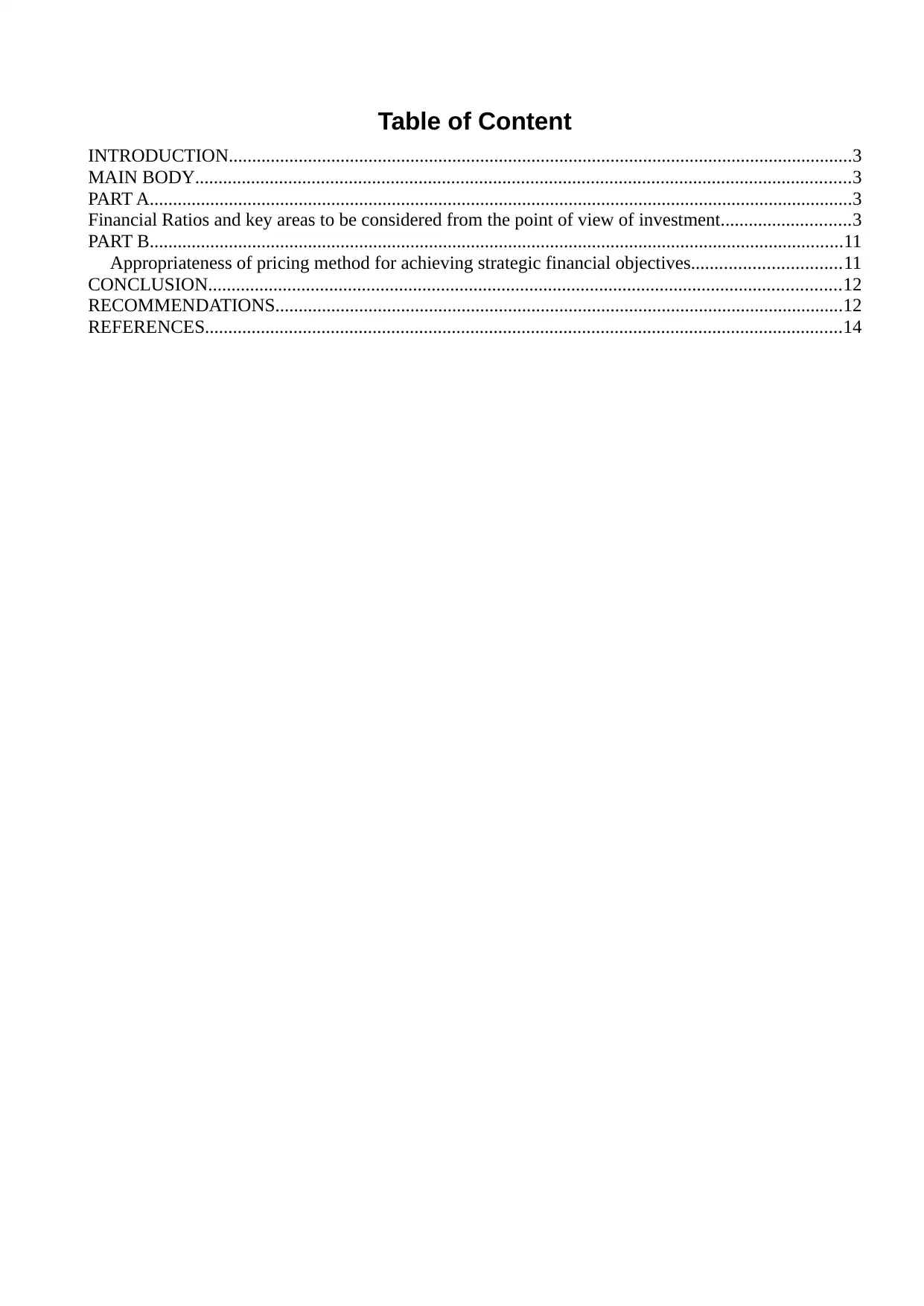
Table of Content
INTRODUCTION......................................................................................................................................3
MAIN BODY.............................................................................................................................................3
PART A.......................................................................................................................................................3
Financial Ratios and key areas to be considered from the point of view of investment............................3
PART B.....................................................................................................................................................11
Appropriateness of pricing method for achieving strategic financial objectives................................11
CONCLUSION........................................................................................................................................12
RECOMMENDATIONS..........................................................................................................................12
REFERENCES.........................................................................................................................................14
INTRODUCTION......................................................................................................................................3
MAIN BODY.............................................................................................................................................3
PART A.......................................................................................................................................................3
Financial Ratios and key areas to be considered from the point of view of investment............................3
PART B.....................................................................................................................................................11
Appropriateness of pricing method for achieving strategic financial objectives................................11
CONCLUSION........................................................................................................................................12
RECOMMENDATIONS..........................................................................................................................12
REFERENCES.........................................................................................................................................14

INTRODUCTION
Financial report is a concise summary of business operations and accounting transaction which has
taken place for a specific accounting period. Financial statements prepared by every company plays a
crucial role for every investor as well as stakeholders in their decision making process. The report is
based on ASOS Plc which is a British online fashion and cosmetic retailer. This company is engaged in
clothing business and provides facility of online shopping. Also, report will discuss about Boohoo
Group Plc, providing services related to fashion and clothing retail business. The report will provide
comparative analysis with the help of financial ratios and their interpretation between two companies
named ASOS Plc and Boohoo Group Plc.
MAIN BODY
PART A
Financial Ratios and key areas to be considered from the point of view of investment.
Particulars ASOS Plc. Boohoo Group Plc.
2018 (in £000) 2018 (in £000)
1. Current Ratio
Current Assets 503.6 215.09
Current Liabilities 558 104.39
Current Ratio = Current
Assets/ Current Liabilities 0.90 2.06
2. Acid Test Ratio
Quick Asset 96 166.84
Current Liabilities 558 104.39
Acid Test Ratio = Current
Assets/ Current Liabilities 0.17 1.60
3. Debtor days
Trade Debtors 42.6 13.84
Revenue Sales 2417.3 579.8
Debtor days = (Trade
Debtors/Revenue Sales) *
365
6.43 8.71
4. Creditor days
Trade Payables 549.7 34.2
Cost of Sales 1180.2 280.43
Creditor days = (Trade
Payables/Cost of
Sales)*365
170.01 44.51
5. Operating Profit
Financial report is a concise summary of business operations and accounting transaction which has
taken place for a specific accounting period. Financial statements prepared by every company plays a
crucial role for every investor as well as stakeholders in their decision making process. The report is
based on ASOS Plc which is a British online fashion and cosmetic retailer. This company is engaged in
clothing business and provides facility of online shopping. Also, report will discuss about Boohoo
Group Plc, providing services related to fashion and clothing retail business. The report will provide
comparative analysis with the help of financial ratios and their interpretation between two companies
named ASOS Plc and Boohoo Group Plc.
MAIN BODY
PART A
Financial Ratios and key areas to be considered from the point of view of investment.
Particulars ASOS Plc. Boohoo Group Plc.
2018 (in £000) 2018 (in £000)
1. Current Ratio
Current Assets 503.6 215.09
Current Liabilities 558 104.39
Current Ratio = Current
Assets/ Current Liabilities 0.90 2.06
2. Acid Test Ratio
Quick Asset 96 166.84
Current Liabilities 558 104.39
Acid Test Ratio = Current
Assets/ Current Liabilities 0.17 1.60
3. Debtor days
Trade Debtors 42.6 13.84
Revenue Sales 2417.3 579.8
Debtor days = (Trade
Debtors/Revenue Sales) *
365
6.43 8.71
4. Creditor days
Trade Payables 549.7 34.2
Cost of Sales 1180.2 280.43
Creditor days = (Trade
Payables/Cost of
Sales)*365
170.01 44.51
5. Operating Profit
You're viewing a preview
Unlock full access by subscribing today!
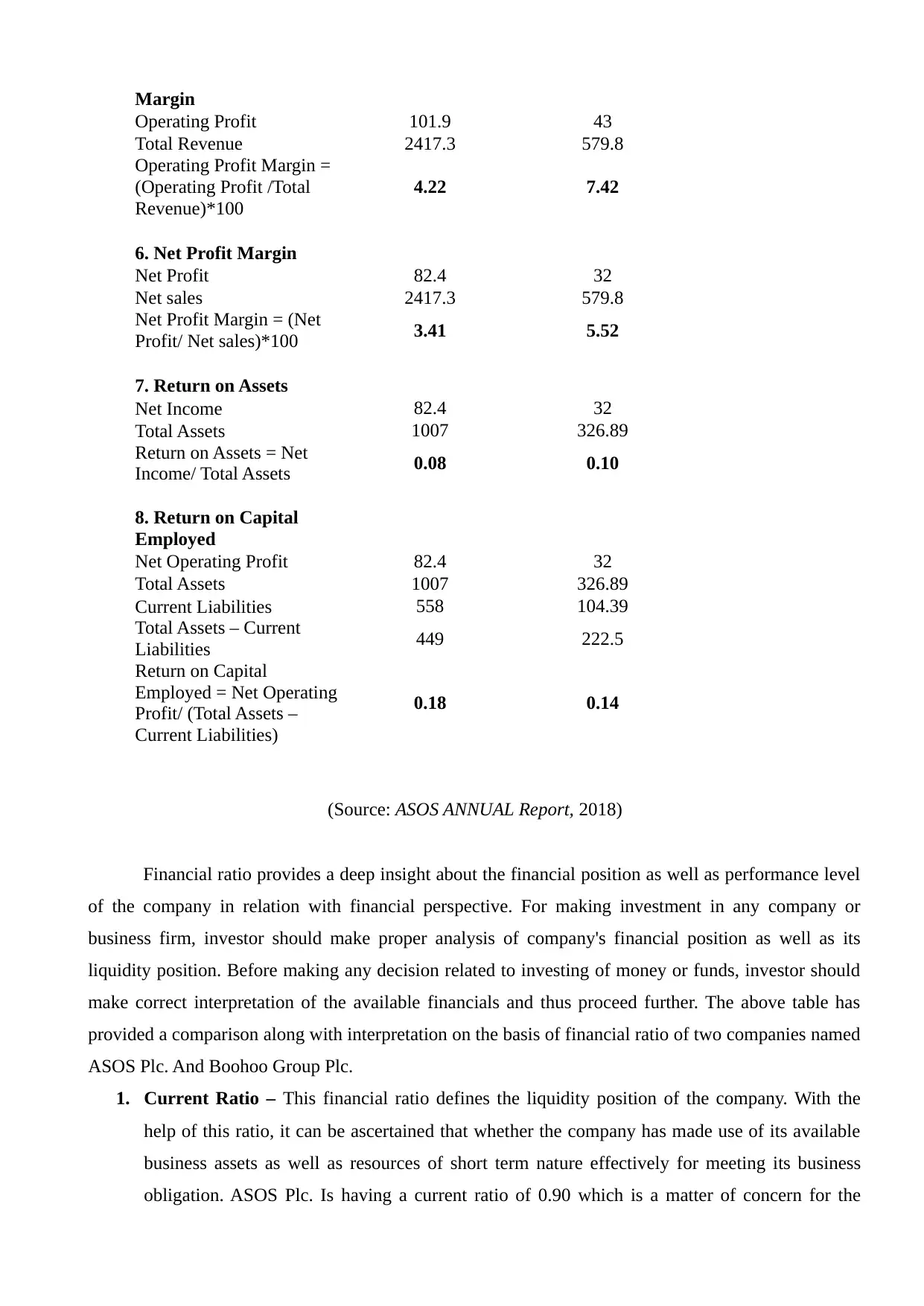
Margin
Operating Profit 101.9 43
Total Revenue 2417.3 579.8
Operating Profit Margin =
(Operating Profit /Total
Revenue)*100
4.22 7.42
6. Net Profit Margin
Net Profit 82.4 32
Net sales 2417.3 579.8
Net Profit Margin = (Net
Profit/ Net sales)*100 3.41 5.52
7. Return on Assets
Net Income 82.4 32
Total Assets 1007 326.89
Return on Assets = Net
Income/ Total Assets 0.08 0.10
8. Return on Capital
Employed
Net Operating Profit 82.4 32
Total Assets 1007 326.89
Current Liabilities 558 104.39
Total Assets – Current
Liabilities 449 222.5
Return on Capital
Employed = Net Operating
Profit/ (Total Assets –
Current Liabilities)
0.18 0.14
(Source: ASOS ANNUAL Report, 2018)
Financial ratio provides a deep insight about the financial position as well as performance level
of the company in relation with financial perspective. For making investment in any company or
business firm, investor should make proper analysis of company's financial position as well as its
liquidity position. Before making any decision related to investing of money or funds, investor should
make correct interpretation of the available financials and thus proceed further. The above table has
provided a comparison along with interpretation on the basis of financial ratio of two companies named
ASOS Plc. And Boohoo Group Plc.
1. Current Ratio – This financial ratio defines the liquidity position of the company. With the
help of this ratio, it can be ascertained that whether the company has made use of its available
business assets as well as resources of short term nature effectively for meeting its business
obligation. ASOS Plc. Is having a current ratio of 0.90 which is a matter of concern for the
Operating Profit 101.9 43
Total Revenue 2417.3 579.8
Operating Profit Margin =
(Operating Profit /Total
Revenue)*100
4.22 7.42
6. Net Profit Margin
Net Profit 82.4 32
Net sales 2417.3 579.8
Net Profit Margin = (Net
Profit/ Net sales)*100 3.41 5.52
7. Return on Assets
Net Income 82.4 32
Total Assets 1007 326.89
Return on Assets = Net
Income/ Total Assets 0.08 0.10
8. Return on Capital
Employed
Net Operating Profit 82.4 32
Total Assets 1007 326.89
Current Liabilities 558 104.39
Total Assets – Current
Liabilities 449 222.5
Return on Capital
Employed = Net Operating
Profit/ (Total Assets –
Current Liabilities)
0.18 0.14
(Source: ASOS ANNUAL Report, 2018)
Financial ratio provides a deep insight about the financial position as well as performance level
of the company in relation with financial perspective. For making investment in any company or
business firm, investor should make proper analysis of company's financial position as well as its
liquidity position. Before making any decision related to investing of money or funds, investor should
make correct interpretation of the available financials and thus proceed further. The above table has
provided a comparison along with interpretation on the basis of financial ratio of two companies named
ASOS Plc. And Boohoo Group Plc.
1. Current Ratio – This financial ratio defines the liquidity position of the company. With the
help of this ratio, it can be ascertained that whether the company has made use of its available
business assets as well as resources of short term nature effectively for meeting its business
obligation. ASOS Plc. Is having a current ratio of 0.90 which is a matter of concern for the
Paraphrase This Document
Need a fresh take? Get an instant paraphrase of this document with our AI Paraphraser
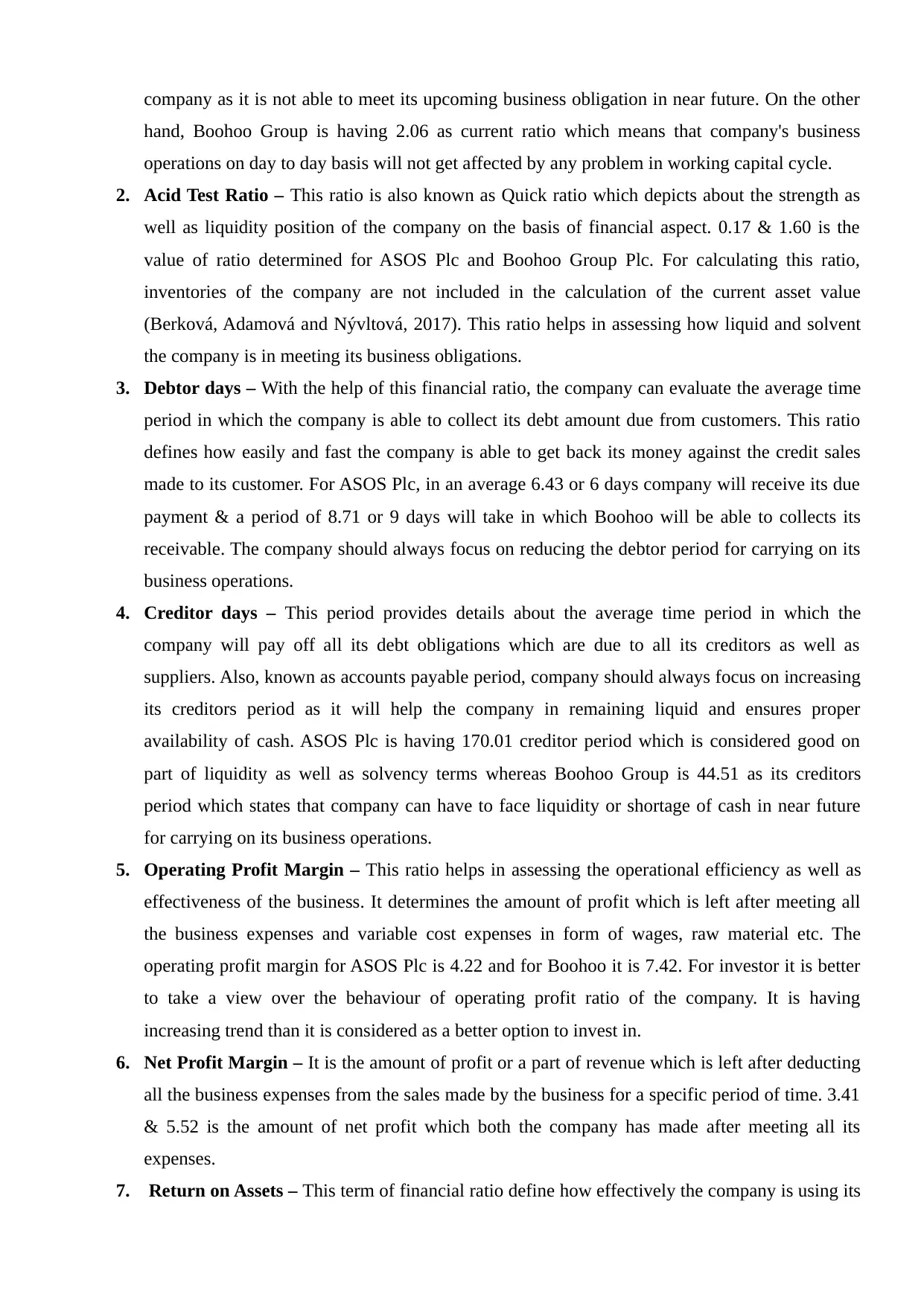
company as it is not able to meet its upcoming business obligation in near future. On the other
hand, Boohoo Group is having 2.06 as current ratio which means that company's business
operations on day to day basis will not get affected by any problem in working capital cycle.
2. Acid Test Ratio – This ratio is also known as Quick ratio which depicts about the strength as
well as liquidity position of the company on the basis of financial aspect. 0.17 & 1.60 is the
value of ratio determined for ASOS Plc and Boohoo Group Plc. For calculating this ratio,
inventories of the company are not included in the calculation of the current asset value
(Berková, Adamová and Nývltová, 2017). This ratio helps in assessing how liquid and solvent
the company is in meeting its business obligations.
3. Debtor days – With the help of this financial ratio, the company can evaluate the average time
period in which the company is able to collect its debt amount due from customers. This ratio
defines how easily and fast the company is able to get back its money against the credit sales
made to its customer. For ASOS Plc, in an average 6.43 or 6 days company will receive its due
payment & a period of 8.71 or 9 days will take in which Boohoo will be able to collects its
receivable. The company should always focus on reducing the debtor period for carrying on its
business operations.
4. Creditor days – This period provides details about the average time period in which the
company will pay off all its debt obligations which are due to all its creditors as well as
suppliers. Also, known as accounts payable period, company should always focus on increasing
its creditors period as it will help the company in remaining liquid and ensures proper
availability of cash. ASOS Plc is having 170.01 creditor period which is considered good on
part of liquidity as well as solvency terms whereas Boohoo Group is 44.51 as its creditors
period which states that company can have to face liquidity or shortage of cash in near future
for carrying on its business operations.
5. Operating Profit Margin – This ratio helps in assessing the operational efficiency as well as
effectiveness of the business. It determines the amount of profit which is left after meeting all
the business expenses and variable cost expenses in form of wages, raw material etc. The
operating profit margin for ASOS Plc is 4.22 and for Boohoo it is 7.42. For investor it is better
to take a view over the behaviour of operating profit ratio of the company. It is having
increasing trend than it is considered as a better option to invest in.
6. Net Profit Margin – It is the amount of profit or a part of revenue which is left after deducting
all the business expenses from the sales made by the business for a specific period of time. 3.41
& 5.52 is the amount of net profit which both the company has made after meeting all its
expenses.
7. Return on Assets – This term of financial ratio define how effectively the company is using its
hand, Boohoo Group is having 2.06 as current ratio which means that company's business
operations on day to day basis will not get affected by any problem in working capital cycle.
2. Acid Test Ratio – This ratio is also known as Quick ratio which depicts about the strength as
well as liquidity position of the company on the basis of financial aspect. 0.17 & 1.60 is the
value of ratio determined for ASOS Plc and Boohoo Group Plc. For calculating this ratio,
inventories of the company are not included in the calculation of the current asset value
(Berková, Adamová and Nývltová, 2017). This ratio helps in assessing how liquid and solvent
the company is in meeting its business obligations.
3. Debtor days – With the help of this financial ratio, the company can evaluate the average time
period in which the company is able to collect its debt amount due from customers. This ratio
defines how easily and fast the company is able to get back its money against the credit sales
made to its customer. For ASOS Plc, in an average 6.43 or 6 days company will receive its due
payment & a period of 8.71 or 9 days will take in which Boohoo will be able to collects its
receivable. The company should always focus on reducing the debtor period for carrying on its
business operations.
4. Creditor days – This period provides details about the average time period in which the
company will pay off all its debt obligations which are due to all its creditors as well as
suppliers. Also, known as accounts payable period, company should always focus on increasing
its creditors period as it will help the company in remaining liquid and ensures proper
availability of cash. ASOS Plc is having 170.01 creditor period which is considered good on
part of liquidity as well as solvency terms whereas Boohoo Group is 44.51 as its creditors
period which states that company can have to face liquidity or shortage of cash in near future
for carrying on its business operations.
5. Operating Profit Margin – This ratio helps in assessing the operational efficiency as well as
effectiveness of the business. It determines the amount of profit which is left after meeting all
the business expenses and variable cost expenses in form of wages, raw material etc. The
operating profit margin for ASOS Plc is 4.22 and for Boohoo it is 7.42. For investor it is better
to take a view over the behaviour of operating profit ratio of the company. It is having
increasing trend than it is considered as a better option to invest in.
6. Net Profit Margin – It is the amount of profit or a part of revenue which is left after deducting
all the business expenses from the sales made by the business for a specific period of time. 3.41
& 5.52 is the amount of net profit which both the company has made after meeting all its
expenses.
7. Return on Assets – This term of financial ratio define how effectively the company is using its
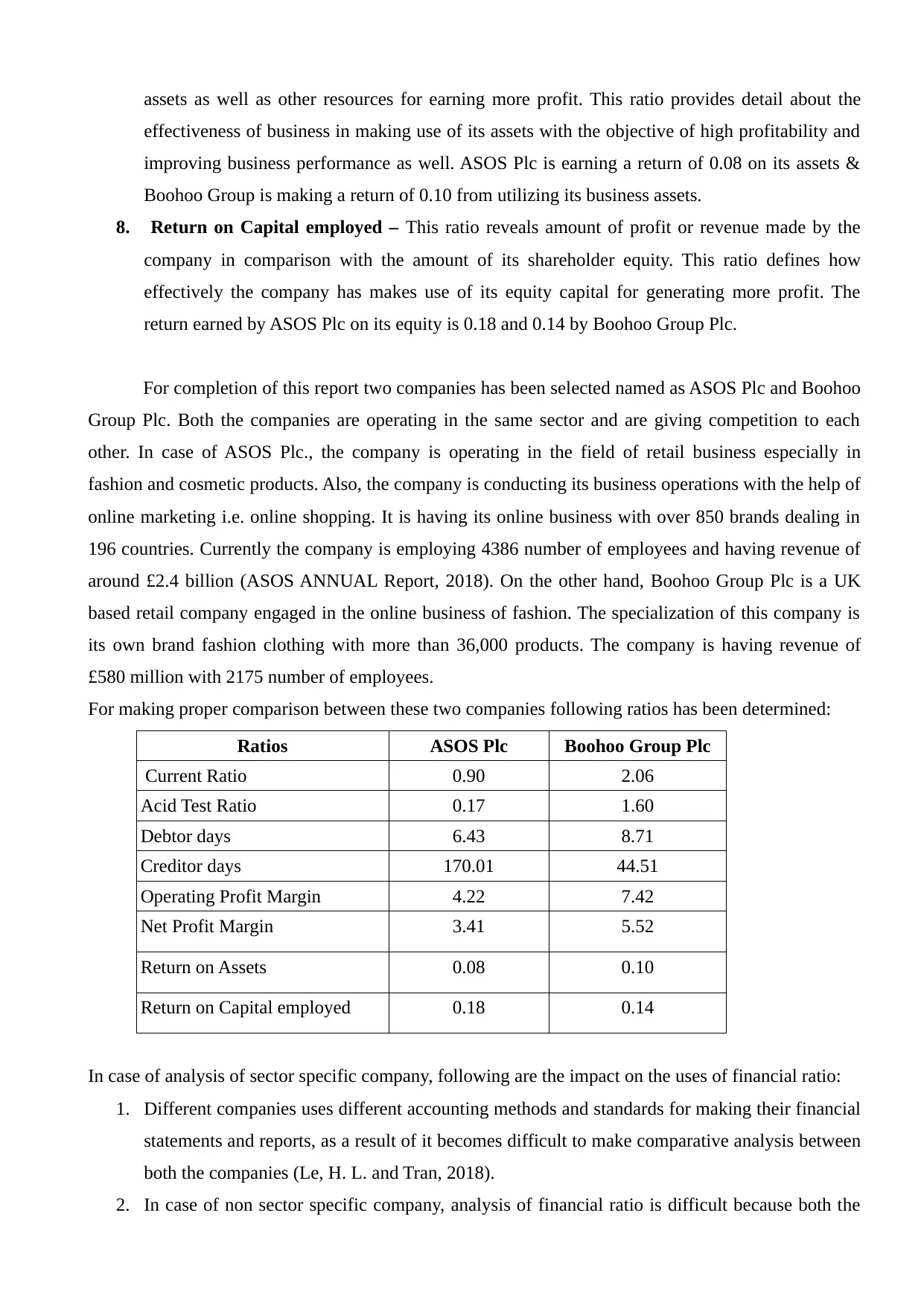
assets as well as other resources for earning more profit. This ratio provides detail about the
effectiveness of business in making use of its assets with the objective of high profitability and
improving business performance as well. ASOS Plc is earning a return of 0.08 on its assets &
Boohoo Group is making a return of 0.10 from utilizing its business assets.
8. Return on Capital employed – This ratio reveals amount of profit or revenue made by the
company in comparison with the amount of its shareholder equity. This ratio defines how
effectively the company has makes use of its equity capital for generating more profit. The
return earned by ASOS Plc on its equity is 0.18 and 0.14 by Boohoo Group Plc.
For completion of this report two companies has been selected named as ASOS Plc and Boohoo
Group Plc. Both the companies are operating in the same sector and are giving competition to each
other. In case of ASOS Plc., the company is operating in the field of retail business especially in
fashion and cosmetic products. Also, the company is conducting its business operations with the help of
online marketing i.e. online shopping. It is having its online business with over 850 brands dealing in
196 countries. Currently the company is employing 4386 number of employees and having revenue of
around £2.4 billion (ASOS ANNUAL Report, 2018). On the other hand, Boohoo Group Plc is a UK
based retail company engaged in the online business of fashion. The specialization of this company is
its own brand fashion clothing with more than 36,000 products. The company is having revenue of
£580 million with 2175 number of employees.
For making proper comparison between these two companies following ratios has been determined:
Ratios ASOS Plc Boohoo Group Plc
Current Ratio 0.90 2.06
Acid Test Ratio 0.17 1.60
Debtor days 6.43 8.71
Creditor days 170.01 44.51
Operating Profit Margin 4.22 7.42
Net Profit Margin 3.41 5.52
Return on Assets 0.08 0.10
Return on Capital employed 0.18 0.14
In case of analysis of sector specific company, following are the impact on the uses of financial ratio:
1. Different companies uses different accounting methods and standards for making their financial
statements and reports, as a result of it becomes difficult to make comparative analysis between
both the companies (Le, H. L. and Tran, 2018).
2. In case of non sector specific company, analysis of financial ratio is difficult because both the
effectiveness of business in making use of its assets with the objective of high profitability and
improving business performance as well. ASOS Plc is earning a return of 0.08 on its assets &
Boohoo Group is making a return of 0.10 from utilizing its business assets.
8. Return on Capital employed – This ratio reveals amount of profit or revenue made by the
company in comparison with the amount of its shareholder equity. This ratio defines how
effectively the company has makes use of its equity capital for generating more profit. The
return earned by ASOS Plc on its equity is 0.18 and 0.14 by Boohoo Group Plc.
For completion of this report two companies has been selected named as ASOS Plc and Boohoo
Group Plc. Both the companies are operating in the same sector and are giving competition to each
other. In case of ASOS Plc., the company is operating in the field of retail business especially in
fashion and cosmetic products. Also, the company is conducting its business operations with the help of
online marketing i.e. online shopping. It is having its online business with over 850 brands dealing in
196 countries. Currently the company is employing 4386 number of employees and having revenue of
around £2.4 billion (ASOS ANNUAL Report, 2018). On the other hand, Boohoo Group Plc is a UK
based retail company engaged in the online business of fashion. The specialization of this company is
its own brand fashion clothing with more than 36,000 products. The company is having revenue of
£580 million with 2175 number of employees.
For making proper comparison between these two companies following ratios has been determined:
Ratios ASOS Plc Boohoo Group Plc
Current Ratio 0.90 2.06
Acid Test Ratio 0.17 1.60
Debtor days 6.43 8.71
Creditor days 170.01 44.51
Operating Profit Margin 4.22 7.42
Net Profit Margin 3.41 5.52
Return on Assets 0.08 0.10
Return on Capital employed 0.18 0.14
In case of analysis of sector specific company, following are the impact on the uses of financial ratio:
1. Different companies uses different accounting methods and standards for making their financial
statements and reports, as a result of it becomes difficult to make comparative analysis between
both the companies (Le, H. L. and Tran, 2018).
2. In case of non sector specific company, analysis of financial ratio is difficult because both the
You're viewing a preview
Unlock full access by subscribing today!
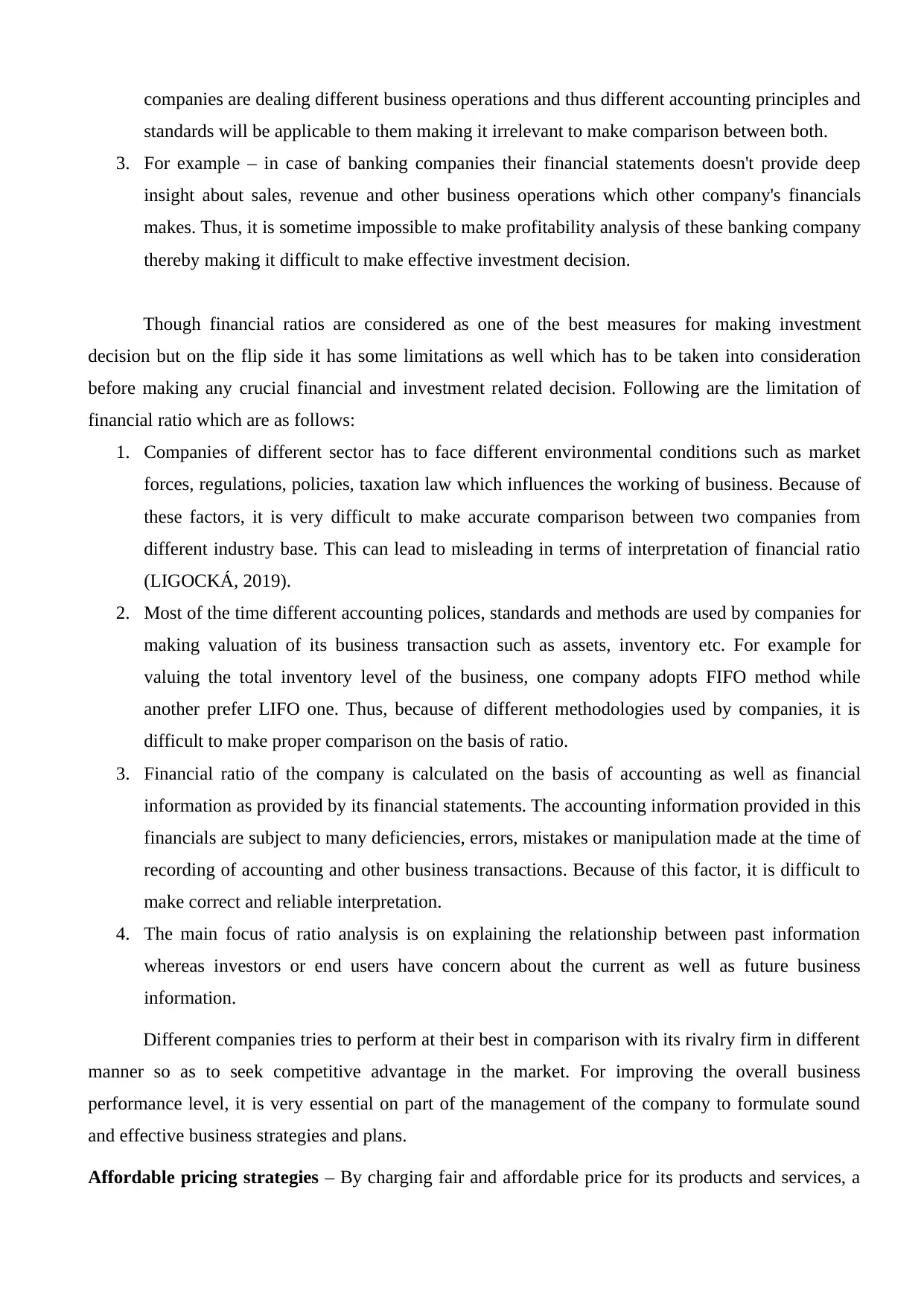
companies are dealing different business operations and thus different accounting principles and
standards will be applicable to them making it irrelevant to make comparison between both.
3. For example – in case of banking companies their financial statements doesn't provide deep
insight about sales, revenue and other business operations which other company's financials
makes. Thus, it is sometime impossible to make profitability analysis of these banking company
thereby making it difficult to make effective investment decision.
Though financial ratios are considered as one of the best measures for making investment
decision but on the flip side it has some limitations as well which has to be taken into consideration
before making any crucial financial and investment related decision. Following are the limitation of
financial ratio which are as follows:
1. Companies of different sector has to face different environmental conditions such as market
forces, regulations, policies, taxation law which influences the working of business. Because of
these factors, it is very difficult to make accurate comparison between two companies from
different industry base. This can lead to misleading in terms of interpretation of financial ratio
(LIGOCKÁ, 2019).
2. Most of the time different accounting polices, standards and methods are used by companies for
making valuation of its business transaction such as assets, inventory etc. For example for
valuing the total inventory level of the business, one company adopts FIFO method while
another prefer LIFO one. Thus, because of different methodologies used by companies, it is
difficult to make proper comparison on the basis of ratio.
3. Financial ratio of the company is calculated on the basis of accounting as well as financial
information as provided by its financial statements. The accounting information provided in this
financials are subject to many deficiencies, errors, mistakes or manipulation made at the time of
recording of accounting and other business transactions. Because of this factor, it is difficult to
make correct and reliable interpretation.
4. The main focus of ratio analysis is on explaining the relationship between past information
whereas investors or end users have concern about the current as well as future business
information.
Different companies tries to perform at their best in comparison with its rivalry firm in different
manner so as to seek competitive advantage in the market. For improving the overall business
performance level, it is very essential on part of the management of the company to formulate sound
and effective business strategies and plans.
Affordable pricing strategies – By charging fair and affordable price for its products and services, a
standards will be applicable to them making it irrelevant to make comparison between both.
3. For example – in case of banking companies their financial statements doesn't provide deep
insight about sales, revenue and other business operations which other company's financials
makes. Thus, it is sometime impossible to make profitability analysis of these banking company
thereby making it difficult to make effective investment decision.
Though financial ratios are considered as one of the best measures for making investment
decision but on the flip side it has some limitations as well which has to be taken into consideration
before making any crucial financial and investment related decision. Following are the limitation of
financial ratio which are as follows:
1. Companies of different sector has to face different environmental conditions such as market
forces, regulations, policies, taxation law which influences the working of business. Because of
these factors, it is very difficult to make accurate comparison between two companies from
different industry base. This can lead to misleading in terms of interpretation of financial ratio
(LIGOCKÁ, 2019).
2. Most of the time different accounting polices, standards and methods are used by companies for
making valuation of its business transaction such as assets, inventory etc. For example for
valuing the total inventory level of the business, one company adopts FIFO method while
another prefer LIFO one. Thus, because of different methodologies used by companies, it is
difficult to make proper comparison on the basis of ratio.
3. Financial ratio of the company is calculated on the basis of accounting as well as financial
information as provided by its financial statements. The accounting information provided in this
financials are subject to many deficiencies, errors, mistakes or manipulation made at the time of
recording of accounting and other business transactions. Because of this factor, it is difficult to
make correct and reliable interpretation.
4. The main focus of ratio analysis is on explaining the relationship between past information
whereas investors or end users have concern about the current as well as future business
information.
Different companies tries to perform at their best in comparison with its rivalry firm in different
manner so as to seek competitive advantage in the market. For improving the overall business
performance level, it is very essential on part of the management of the company to formulate sound
and effective business strategies and plans.
Affordable pricing strategies – By charging fair and affordable price for its products and services, a
Paraphrase This Document
Need a fresh take? Get an instant paraphrase of this document with our AI Paraphraser
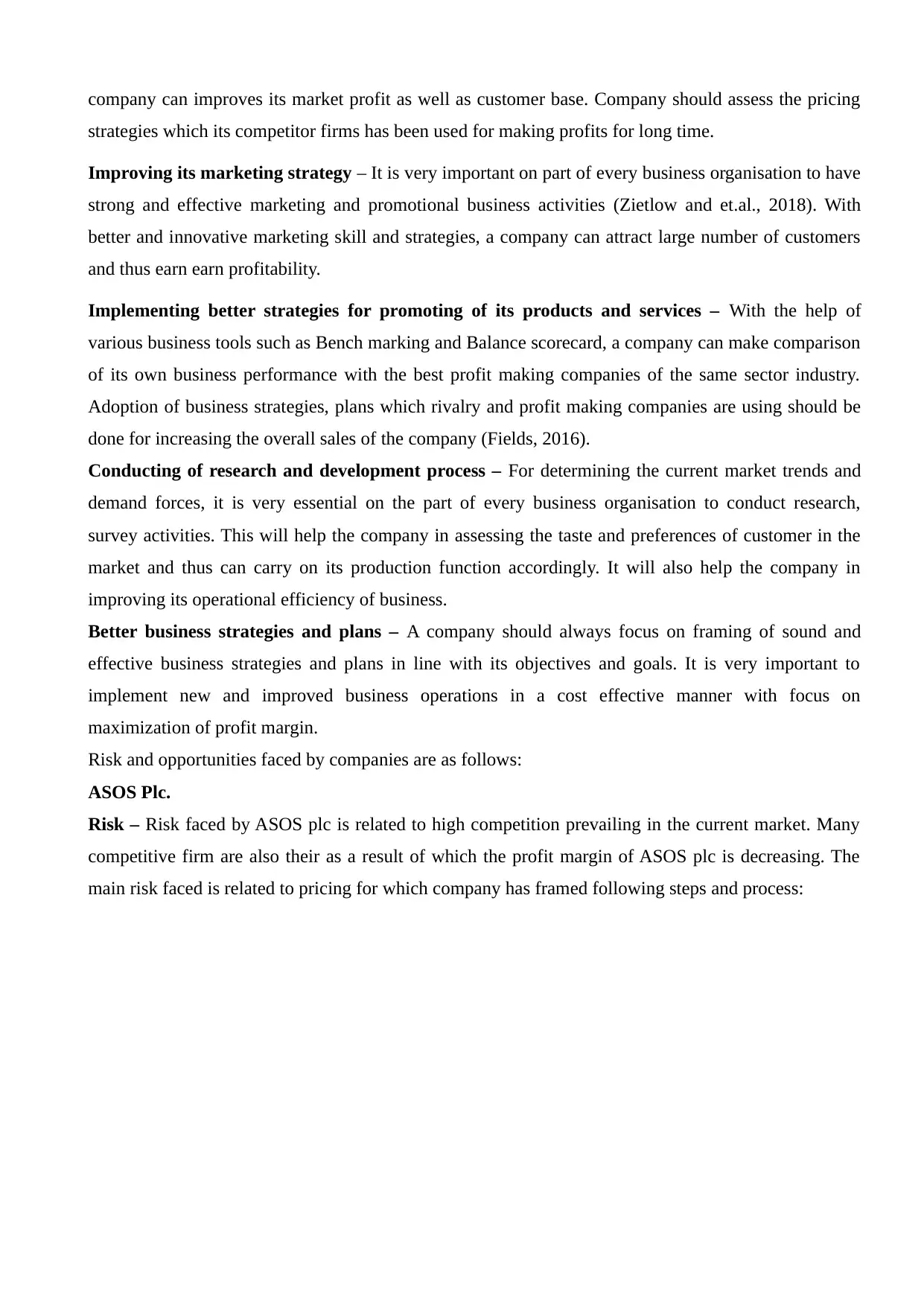
company can improves its market profit as well as customer base. Company should assess the pricing
strategies which its competitor firms has been used for making profits for long time.
Improving its marketing strategy – It is very important on part of every business organisation to have
strong and effective marketing and promotional business activities (Zietlow and et.al., 2018). With
better and innovative marketing skill and strategies, a company can attract large number of customers
and thus earn earn profitability.
Implementing better strategies for promoting of its products and services – With the help of
various business tools such as Bench marking and Balance scorecard, a company can make comparison
of its own business performance with the best profit making companies of the same sector industry.
Adoption of business strategies, plans which rivalry and profit making companies are using should be
done for increasing the overall sales of the company (Fields, 2016).
Conducting of research and development process – For determining the current market trends and
demand forces, it is very essential on the part of every business organisation to conduct research,
survey activities. This will help the company in assessing the taste and preferences of customer in the
market and thus can carry on its production function accordingly. It will also help the company in
improving its operational efficiency of business.
Better business strategies and plans – A company should always focus on framing of sound and
effective business strategies and plans in line with its objectives and goals. It is very important to
implement new and improved business operations in a cost effective manner with focus on
maximization of profit margin.
Risk and opportunities faced by companies are as follows:
ASOS Plc.
Risk – Risk faced by ASOS plc is related to high competition prevailing in the current market. Many
competitive firm are also their as a result of which the profit margin of ASOS plc is decreasing. The
main risk faced is related to pricing for which company has framed following steps and process:
strategies which its competitor firms has been used for making profits for long time.
Improving its marketing strategy – It is very important on part of every business organisation to have
strong and effective marketing and promotional business activities (Zietlow and et.al., 2018). With
better and innovative marketing skill and strategies, a company can attract large number of customers
and thus earn earn profitability.
Implementing better strategies for promoting of its products and services – With the help of
various business tools such as Bench marking and Balance scorecard, a company can make comparison
of its own business performance with the best profit making companies of the same sector industry.
Adoption of business strategies, plans which rivalry and profit making companies are using should be
done for increasing the overall sales of the company (Fields, 2016).
Conducting of research and development process – For determining the current market trends and
demand forces, it is very essential on the part of every business organisation to conduct research,
survey activities. This will help the company in assessing the taste and preferences of customer in the
market and thus can carry on its production function accordingly. It will also help the company in
improving its operational efficiency of business.
Better business strategies and plans – A company should always focus on framing of sound and
effective business strategies and plans in line with its objectives and goals. It is very important to
implement new and improved business operations in a cost effective manner with focus on
maximization of profit margin.
Risk and opportunities faced by companies are as follows:
ASOS Plc.
Risk – Risk faced by ASOS plc is related to high competition prevailing in the current market. Many
competitive firm are also their as a result of which the profit margin of ASOS plc is decreasing. The
main risk faced is related to pricing for which company has framed following steps and process:
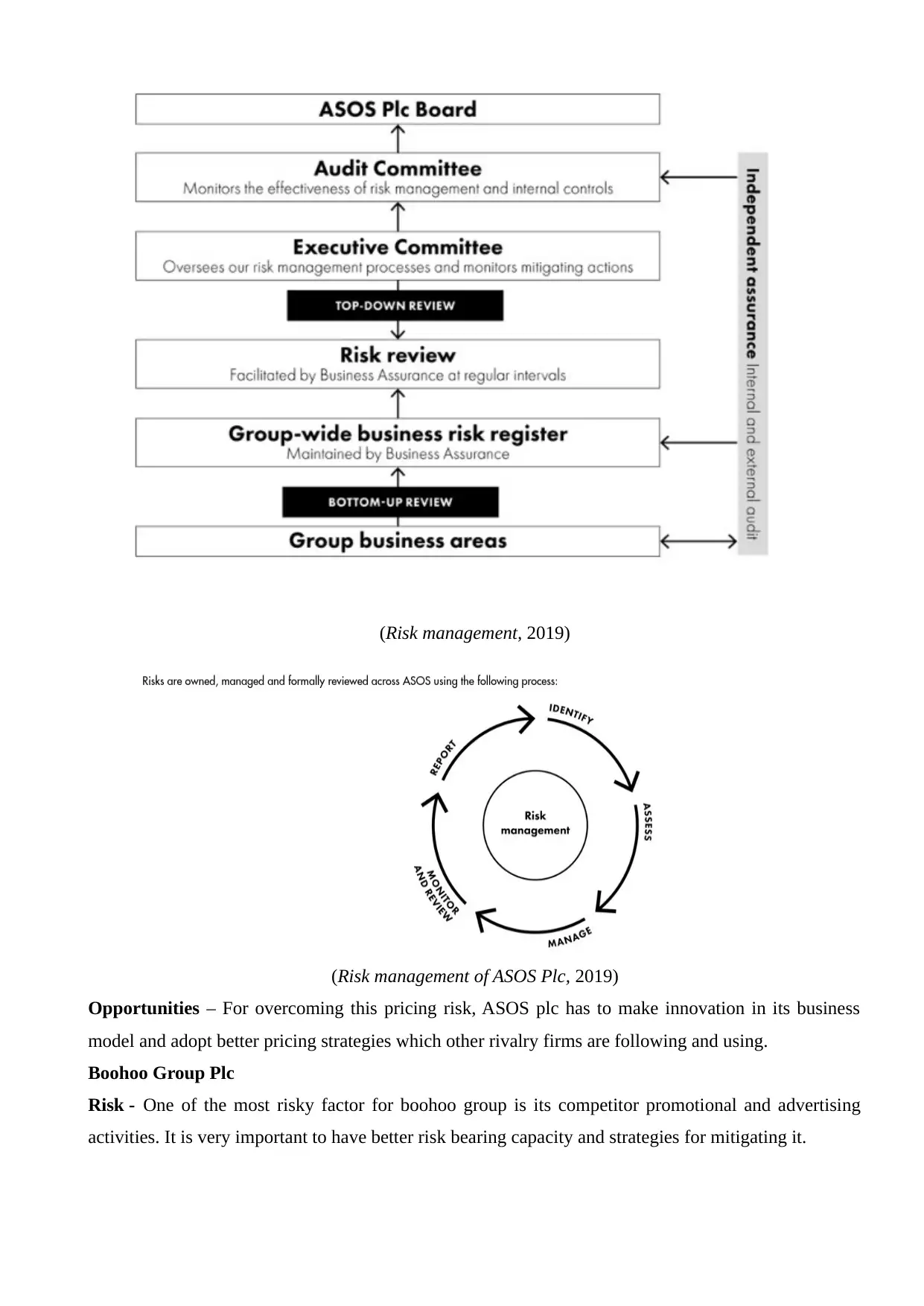
(Risk management, 2019)
(Risk management of ASOS Plc, 2019)
Opportunities – For overcoming this pricing risk, ASOS plc has to make innovation in its business
model and adopt better pricing strategies which other rivalry firms are following and using.
Boohoo Group Plc
Risk - One of the most risky factor for boohoo group is its competitor promotional and advertising
activities. It is very important to have better risk bearing capacity and strategies for mitigating it.
(Risk management of ASOS Plc, 2019)
Opportunities – For overcoming this pricing risk, ASOS plc has to make innovation in its business
model and adopt better pricing strategies which other rivalry firms are following and using.
Boohoo Group Plc
Risk - One of the most risky factor for boohoo group is its competitor promotional and advertising
activities. It is very important to have better risk bearing capacity and strategies for mitigating it.
You're viewing a preview
Unlock full access by subscribing today!
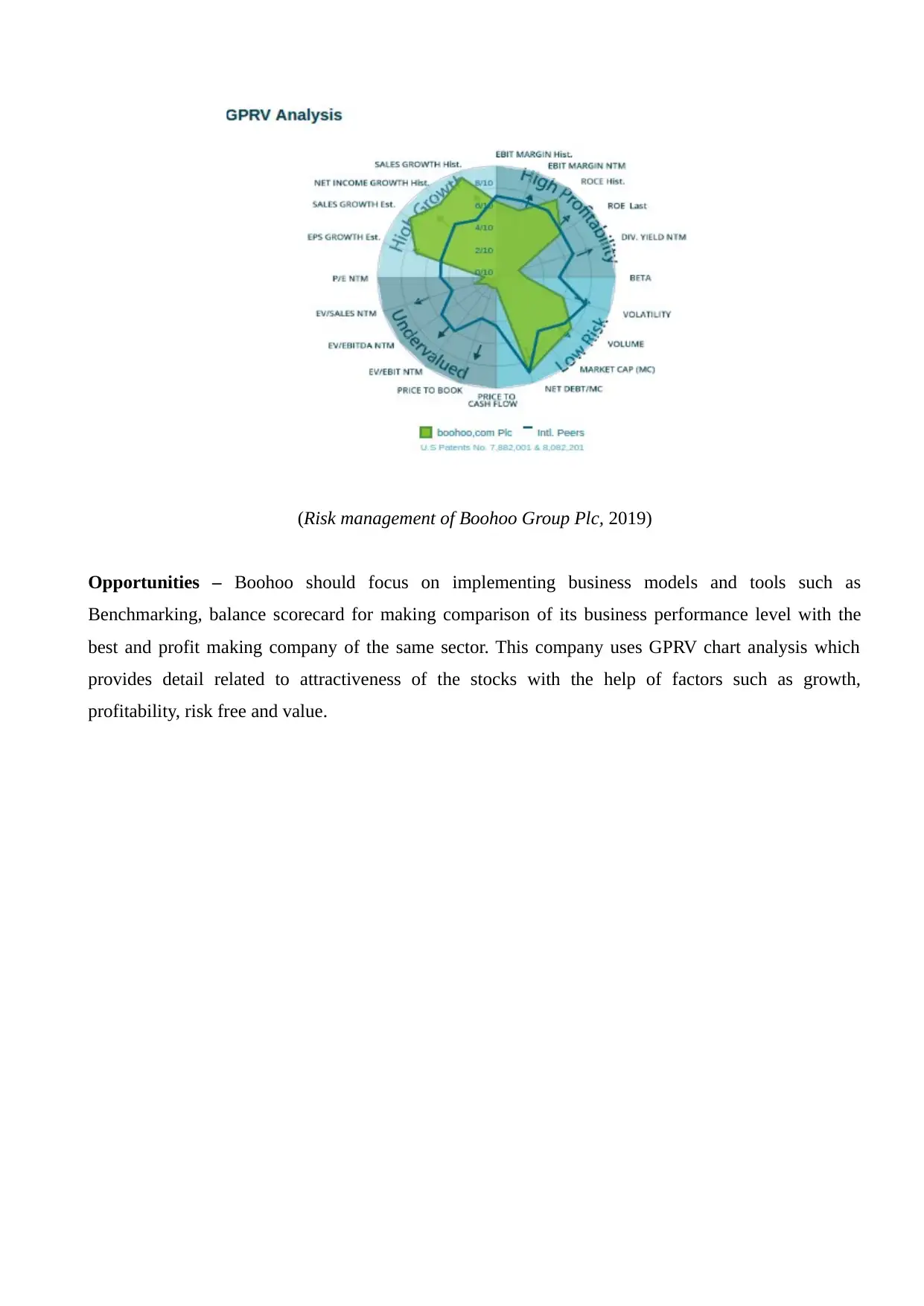
(Risk management of Boohoo Group Plc, 2019)
Opportunities – Boohoo should focus on implementing business models and tools such as
Benchmarking, balance scorecard for making comparison of its business performance level with the
best and profit making company of the same sector. This company uses GPRV chart analysis which
provides detail related to attractiveness of the stocks with the help of factors such as growth,
profitability, risk free and value.
Opportunities – Boohoo should focus on implementing business models and tools such as
Benchmarking, balance scorecard for making comparison of its business performance level with the
best and profit making company of the same sector. This company uses GPRV chart analysis which
provides detail related to attractiveness of the stocks with the help of factors such as growth,
profitability, risk free and value.
Paraphrase This Document
Need a fresh take? Get an instant paraphrase of this document with our AI Paraphraser
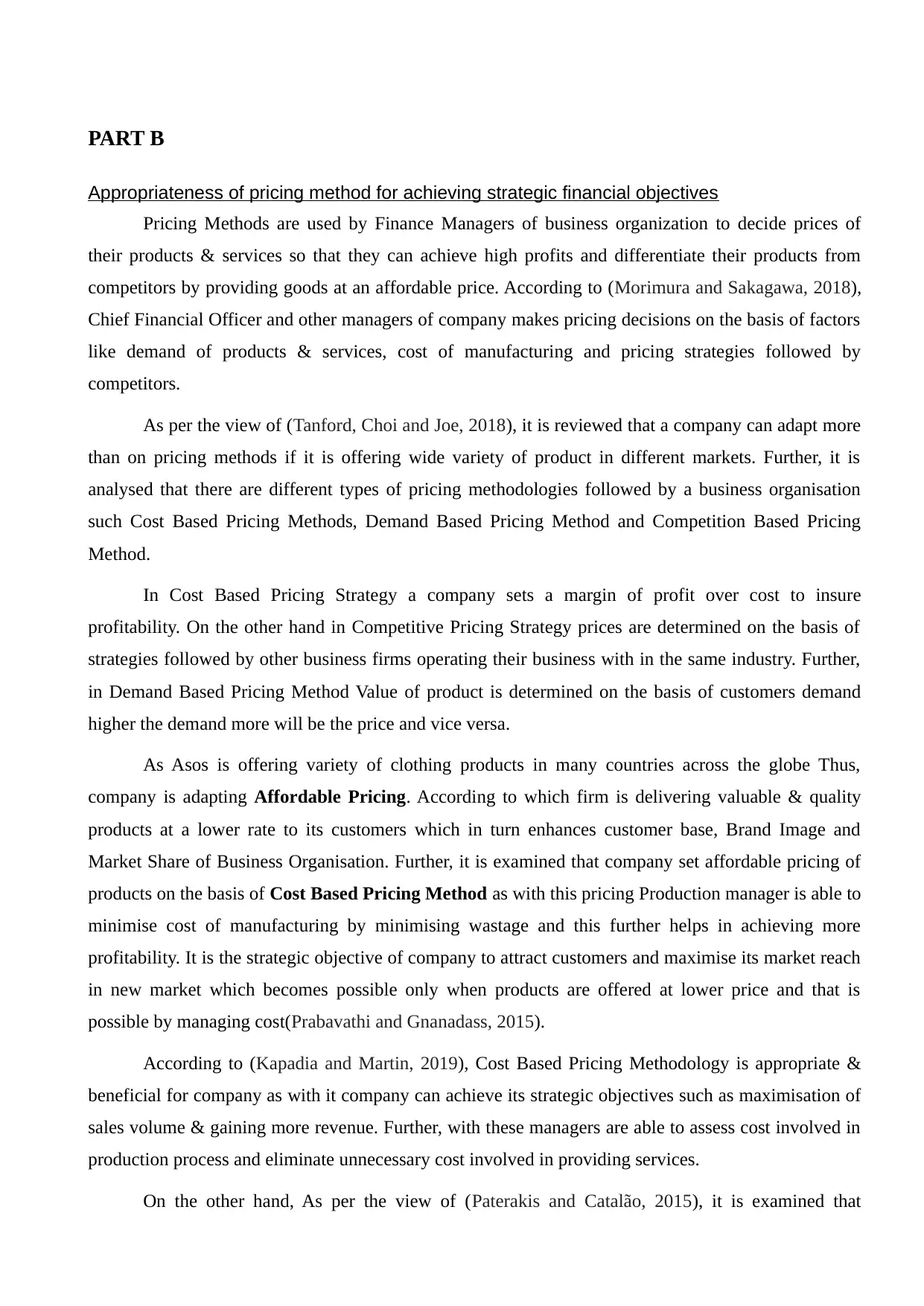
PART B
Appropriateness of pricing method for achieving strategic financial objectives
Pricing Methods are used by Finance Managers of business organization to decide prices of
their products & services so that they can achieve high profits and differentiate their products from
competitors by providing goods at an affordable price. According to (Morimura and Sakagawa, 2018),
Chief Financial Officer and other managers of company makes pricing decisions on the basis of factors
like demand of products & services, cost of manufacturing and pricing strategies followed by
competitors.
As per the view of (Tanford, Choi and Joe, 2018), it is reviewed that a company can adapt more
than on pricing methods if it is offering wide variety of product in different markets. Further, it is
analysed that there are different types of pricing methodologies followed by a business organisation
such Cost Based Pricing Methods, Demand Based Pricing Method and Competition Based Pricing
Method.
In Cost Based Pricing Strategy a company sets a margin of profit over cost to insure
profitability. On the other hand in Competitive Pricing Strategy prices are determined on the basis of
strategies followed by other business firms operating their business with in the same industry. Further,
in Demand Based Pricing Method Value of product is determined on the basis of customers demand
higher the demand more will be the price and vice versa.
As Asos is offering variety of clothing products in many countries across the globe Thus,
company is adapting Affordable Pricing. According to which firm is delivering valuable & quality
products at a lower rate to its customers which in turn enhances customer base, Brand Image and
Market Share of Business Organisation. Further, it is examined that company set affordable pricing of
products on the basis of Cost Based Pricing Method as with this pricing Production manager is able to
minimise cost of manufacturing by minimising wastage and this further helps in achieving more
profitability. It is the strategic objective of company to attract customers and maximise its market reach
in new market which becomes possible only when products are offered at lower price and that is
possible by managing cost(Prabavathi and Gnanadass, 2015).
According to (Kapadia and Martin, 2019), Cost Based Pricing Methodology is appropriate &
beneficial for company as with it company can achieve its strategic objectives such as maximisation of
sales volume & gaining more revenue. Further, with these managers are able to assess cost involved in
production process and eliminate unnecessary cost involved in providing services.
On the other hand, As per the view of (Paterakis and Catalão, 2015), it is examined that
Appropriateness of pricing method for achieving strategic financial objectives
Pricing Methods are used by Finance Managers of business organization to decide prices of
their products & services so that they can achieve high profits and differentiate their products from
competitors by providing goods at an affordable price. According to (Morimura and Sakagawa, 2018),
Chief Financial Officer and other managers of company makes pricing decisions on the basis of factors
like demand of products & services, cost of manufacturing and pricing strategies followed by
competitors.
As per the view of (Tanford, Choi and Joe, 2018), it is reviewed that a company can adapt more
than on pricing methods if it is offering wide variety of product in different markets. Further, it is
analysed that there are different types of pricing methodologies followed by a business organisation
such Cost Based Pricing Methods, Demand Based Pricing Method and Competition Based Pricing
Method.
In Cost Based Pricing Strategy a company sets a margin of profit over cost to insure
profitability. On the other hand in Competitive Pricing Strategy prices are determined on the basis of
strategies followed by other business firms operating their business with in the same industry. Further,
in Demand Based Pricing Method Value of product is determined on the basis of customers demand
higher the demand more will be the price and vice versa.
As Asos is offering variety of clothing products in many countries across the globe Thus,
company is adapting Affordable Pricing. According to which firm is delivering valuable & quality
products at a lower rate to its customers which in turn enhances customer base, Brand Image and
Market Share of Business Organisation. Further, it is examined that company set affordable pricing of
products on the basis of Cost Based Pricing Method as with this pricing Production manager is able to
minimise cost of manufacturing by minimising wastage and this further helps in achieving more
profitability. It is the strategic objective of company to attract customers and maximise its market reach
in new market which becomes possible only when products are offered at lower price and that is
possible by managing cost(Prabavathi and Gnanadass, 2015).
According to (Kapadia and Martin, 2019), Cost Based Pricing Methodology is appropriate &
beneficial for company as with it company can achieve its strategic objectives such as maximisation of
sales volume & gaining more revenue. Further, with these managers are able to assess cost involved in
production process and eliminate unnecessary cost involved in providing services.
On the other hand, As per the view of (Paterakis and Catalão, 2015), it is examined that
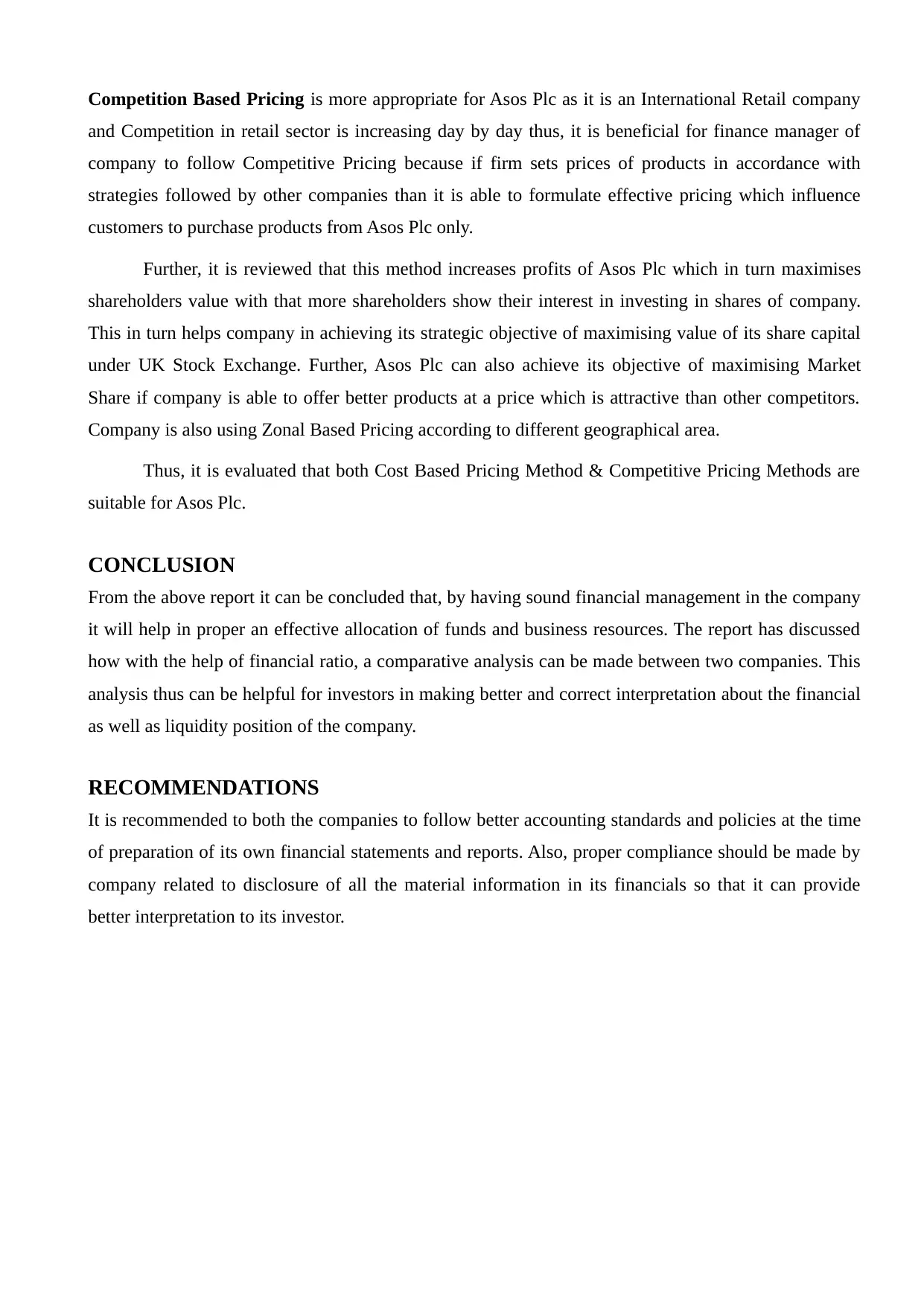
Competition Based Pricing is more appropriate for Asos Plc as it is an International Retail company
and Competition in retail sector is increasing day by day thus, it is beneficial for finance manager of
company to follow Competitive Pricing because if firm sets prices of products in accordance with
strategies followed by other companies than it is able to formulate effective pricing which influence
customers to purchase products from Asos Plc only.
Further, it is reviewed that this method increases profits of Asos Plc which in turn maximises
shareholders value with that more shareholders show their interest in investing in shares of company.
This in turn helps company in achieving its strategic objective of maximising value of its share capital
under UK Stock Exchange. Further, Asos Plc can also achieve its objective of maximising Market
Share if company is able to offer better products at a price which is attractive than other competitors.
Company is also using Zonal Based Pricing according to different geographical area.
Thus, it is evaluated that both Cost Based Pricing Method & Competitive Pricing Methods are
suitable for Asos Plc.
CONCLUSION
From the above report it can be concluded that, by having sound financial management in the company
it will help in proper an effective allocation of funds and business resources. The report has discussed
how with the help of financial ratio, a comparative analysis can be made between two companies. This
analysis thus can be helpful for investors in making better and correct interpretation about the financial
as well as liquidity position of the company.
RECOMMENDATIONS
It is recommended to both the companies to follow better accounting standards and policies at the time
of preparation of its own financial statements and reports. Also, proper compliance should be made by
company related to disclosure of all the material information in its financials so that it can provide
better interpretation to its investor.
and Competition in retail sector is increasing day by day thus, it is beneficial for finance manager of
company to follow Competitive Pricing because if firm sets prices of products in accordance with
strategies followed by other companies than it is able to formulate effective pricing which influence
customers to purchase products from Asos Plc only.
Further, it is reviewed that this method increases profits of Asos Plc which in turn maximises
shareholders value with that more shareholders show their interest in investing in shares of company.
This in turn helps company in achieving its strategic objective of maximising value of its share capital
under UK Stock Exchange. Further, Asos Plc can also achieve its objective of maximising Market
Share if company is able to offer better products at a price which is attractive than other competitors.
Company is also using Zonal Based Pricing according to different geographical area.
Thus, it is evaluated that both Cost Based Pricing Method & Competitive Pricing Methods are
suitable for Asos Plc.
CONCLUSION
From the above report it can be concluded that, by having sound financial management in the company
it will help in proper an effective allocation of funds and business resources. The report has discussed
how with the help of financial ratio, a comparative analysis can be made between two companies. This
analysis thus can be helpful for investors in making better and correct interpretation about the financial
as well as liquidity position of the company.
RECOMMENDATIONS
It is recommended to both the companies to follow better accounting standards and policies at the time
of preparation of its own financial statements and reports. Also, proper compliance should be made by
company related to disclosure of all the material information in its financials so that it can provide
better interpretation to its investor.
You're viewing a preview
Unlock full access by subscribing today!

REFERENCES
Books and Journals
Barr, M. J., & McClellan, G. S. (2018). Budgets and financial management in higher education. John
`Wiley & Sons.
Berková, I., Adamová, M., & Nývltová, K. (2017). Realtionships between Fiancial and Learning and
Growth Perspectives in BSC. Acta Universitatis Agriculturae et Silviculturae Mendelianae
Brunensis. 65(6). 1841-1850.
Fields, E. (2016). The essentials of finance and accounting for nonfinancial managers. Amacom.
Finkler, S. A., Smith, D. L., & Calabrese, T. D. (2018). Financial management for public, health, and
not-for-profit organizations. CQ Press.
Gitman, L. J., Juchau, R., & Flanagan, J. (2015). Principles of managerial finance. Pearson Higher
Education AU.
Kapadia, S. N. & Martin, (2019). Strategies for improving hepatitis C treatment access in the United
States: state officials address high drug prices, stigma, and building treatment
capacity. Journal of Public Health Management and Practice. 25(3). pp.245-252.
Le, H. L., Vu, K. T., Du, N. K., & Tran, M. D. (2018). Impact of working capital management on
financial performance: The case of Vietnam. International Journal of Applied Economics,
Finance and Accounting. 3(1). 15-20.
LIGOCKÁ, M. (2019). The Effect of Financial Ratios on the Stock Prices: Evidence from the Polish
Stock Exchange. Economic Studies & Analyses/Acta VSFS. 13(1).
Litman, T., (2018). Parking Management Strategies. In Parking Management Best Practices (pp.
86-225). Routledge.
Morimura, F. & Sakagawa, Y., (2018). Information technology use in retail chains: Impact on the
standardisation of pricing and promotion strategies and performance. Journal of Retailing and
Consumer Services. 45. pp.81-91.
Paterakis, N. G. & Catalão, J. P., (2015). Optimal household appliances scheduling under day- ahead
pricing and load-shaping demand response strategies. IEEE Transactions on Industrial
Informatics. 11(6). pp.1509-1519.
Prabavathi, M. & Gnanadass, R., (2015). Energy bidding strategies for restructured electricity
market. International Journal of Electrical Power & Energy Systems. 64. pp.956-966.
Salas, O. A., & Campos, M. J. S. (2016). Finance and Accounting for Managers (Vol. 28). Profit
Editorial.
Setiawan, H., & Amboningtyas, D. (2018). FINANCIAL RATIO ANALYSIS FOR PREDICTING
FINANCIAL DISTRESS CONDITIONS (Study on Telecommunication Companies Listed In
Indonesia Stock Exchange Period 2010-2016). Journal of Management. 4(4).
Books and Journals
Barr, M. J., & McClellan, G. S. (2018). Budgets and financial management in higher education. John
`Wiley & Sons.
Berková, I., Adamová, M., & Nývltová, K. (2017). Realtionships between Fiancial and Learning and
Growth Perspectives in BSC. Acta Universitatis Agriculturae et Silviculturae Mendelianae
Brunensis. 65(6). 1841-1850.
Fields, E. (2016). The essentials of finance and accounting for nonfinancial managers. Amacom.
Finkler, S. A., Smith, D. L., & Calabrese, T. D. (2018). Financial management for public, health, and
not-for-profit organizations. CQ Press.
Gitman, L. J., Juchau, R., & Flanagan, J. (2015). Principles of managerial finance. Pearson Higher
Education AU.
Kapadia, S. N. & Martin, (2019). Strategies for improving hepatitis C treatment access in the United
States: state officials address high drug prices, stigma, and building treatment
capacity. Journal of Public Health Management and Practice. 25(3). pp.245-252.
Le, H. L., Vu, K. T., Du, N. K., & Tran, M. D. (2018). Impact of working capital management on
financial performance: The case of Vietnam. International Journal of Applied Economics,
Finance and Accounting. 3(1). 15-20.
LIGOCKÁ, M. (2019). The Effect of Financial Ratios on the Stock Prices: Evidence from the Polish
Stock Exchange. Economic Studies & Analyses/Acta VSFS. 13(1).
Litman, T., (2018). Parking Management Strategies. In Parking Management Best Practices (pp.
86-225). Routledge.
Morimura, F. & Sakagawa, Y., (2018). Information technology use in retail chains: Impact on the
standardisation of pricing and promotion strategies and performance. Journal of Retailing and
Consumer Services. 45. pp.81-91.
Paterakis, N. G. & Catalão, J. P., (2015). Optimal household appliances scheduling under day- ahead
pricing and load-shaping demand response strategies. IEEE Transactions on Industrial
Informatics. 11(6). pp.1509-1519.
Prabavathi, M. & Gnanadass, R., (2015). Energy bidding strategies for restructured electricity
market. International Journal of Electrical Power & Energy Systems. 64. pp.956-966.
Salas, O. A., & Campos, M. J. S. (2016). Finance and Accounting for Managers (Vol. 28). Profit
Editorial.
Setiawan, H., & Amboningtyas, D. (2018). FINANCIAL RATIO ANALYSIS FOR PREDICTING
FINANCIAL DISTRESS CONDITIONS (Study on Telecommunication Companies Listed In
Indonesia Stock Exchange Period 2010-2016). Journal of Management. 4(4).
Paraphrase This Document
Need a fresh take? Get an instant paraphrase of this document with our AI Paraphraser

Statman, M. (2018). Behavioral Finance Lessons for Asset Managers. The Journal of Portfolio
Management. 44(7). 135-147.
Tanford, S., Choi, C. & Joe, S. J., (2018). How Pricing Strategies Influence Willingness-to-pay:
Anchoring and Framing Effects. Journal of Travel Research.
Zietlow, J.& et.al., (2018). Financial management for nonprofit organizations: policies and practices.
John Wiley & Sons.
Online
ASOS ANNUAL Report. 2018. [Online]. Available through:
<https://www.asosplc.com/~/media/Files/A/Asos-V2/reports-and-presentations/26-10-2018-ar-
v2.PDF>.
Boohoo Group Plc. 2019. [Online]. Available through: <https://en.wikipedia.org/wiki/Boohoo.com>.
Risk management of ASOS Plc. 2019. [Online]. Available through:
<https://www.asosplc.com/investors/2018-year-in-review/risk>.
Risk management of Boohoo Group Plc. 2019. [Online]. Available through:
<https://www.infrontanalytics.com/fe-EN/40300EX/boohoo-com-Plc/gprv-risk>.
The most important financial ratios for new investors. 2018. [Online]. Available through:
<https://www.thebalance.com/financial-ratio-guide-357501>.
Management. 44(7). 135-147.
Tanford, S., Choi, C. & Joe, S. J., (2018). How Pricing Strategies Influence Willingness-to-pay:
Anchoring and Framing Effects. Journal of Travel Research.
Zietlow, J.& et.al., (2018). Financial management for nonprofit organizations: policies and practices.
John Wiley & Sons.
Online
ASOS ANNUAL Report. 2018. [Online]. Available through:
<https://www.asosplc.com/~/media/Files/A/Asos-V2/reports-and-presentations/26-10-2018-ar-
v2.PDF>.
Boohoo Group Plc. 2019. [Online]. Available through: <https://en.wikipedia.org/wiki/Boohoo.com>.
Risk management of ASOS Plc. 2019. [Online]. Available through:
<https://www.asosplc.com/investors/2018-year-in-review/risk>.
Risk management of Boohoo Group Plc. 2019. [Online]. Available through:
<https://www.infrontanalytics.com/fe-EN/40300EX/boohoo-com-Plc/gprv-risk>.
The most important financial ratios for new investors. 2018. [Online]. Available through:
<https://www.thebalance.com/financial-ratio-guide-357501>.
1 out of 14
Related Documents
Your All-in-One AI-Powered Toolkit for Academic Success.
+13062052269
info@desklib.com
Available 24*7 on WhatsApp / Email
![[object Object]](/_next/static/media/star-bottom.7253800d.svg)
Unlock your academic potential
© 2024 | Zucol Services PVT LTD | All rights reserved.





